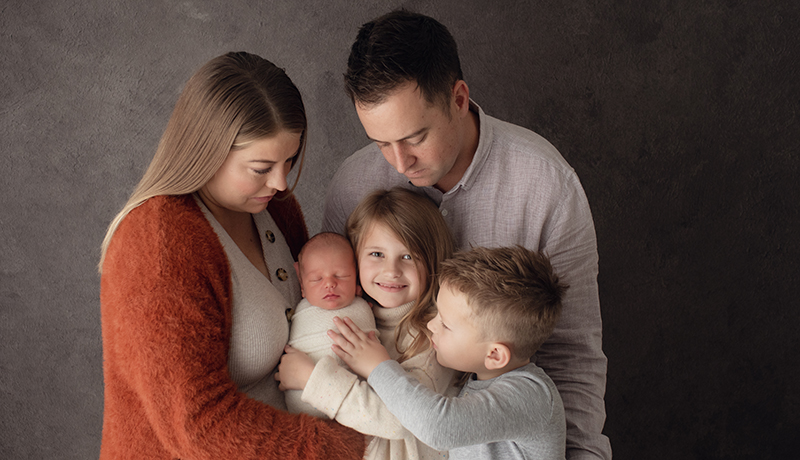
Lauren and Glenn Raphael with daughter Isla, who has autism, son Ashton, and baby Magnus.
Credit: Michelle Jones, Little Brown Rabbit Photography.
Video technology is helping autism researchers learn more about the earliest features of autism, and in turn is helping families gain access to better interventions.
Worry. Every parent does it, but for those who have children with disabilities, it can be all-consuming.
For Perth mother Lauren, autism – and the worry that goes with it – often consumes her thoughts. Her seven-year-old daughter Isla has autism spectrum disorder, a diagnosis she received at the age of four.
“‘What will she eat today?’, ‘Will she ever learn to read or ride a bike?’ – you worry if they will be able to live independently one day,” Lauren said. “You strive to remain positive and set them up to achieve but it doesn’t stop those thoughts creeping in.”
Now, with the arrival of their third child Magnus, Lauren and her husband are trying not to worry about the fact that Isla’s experience with autism means their newborn has a heightened chance of developing differently.
Research has shown children with a family history of autism are more likely to develop autism or other developmental disorders – with children who have a full sibling or biological parent with autism 20 per cent more likely.
This knowledge has spurred CliniKids, the first clinical branch of the Telethon Kids Institute, to launch a world-first trial that uses video technology to help these babies improve their brain development from birth.
Professor Andrew Whitehouse, Director of CliniKids and Telethon Kids Institute Angela Wright Bennett Chair of Autism Research, said the Communicating and Understanding your Baby (CUB) Study was built on a previous study – AICES – that showed the benefits of video interventions on the development of infants.
“This trial is helping researchers get one step closer to improving how we provide support to children on the autism spectrum,” Professor Whitehouse said.
Parents receiving the novel therapy will be filmed interacting with their baby, and will then receive structured feedback and tips from a clinician to help with their baby’s brain development and to build communication skills.
Lauren said her family were keen to be involved in the trial because they wanted to help Magnus should he go on to develop differently, but also to help families faced with similar circumstances.
“Early intervention is paramount, and it would be good to have some tools to use should some red flags become apparent,” Lauren said. “Having a team of experts to oversee the development of your child is highly reassuring.”
Anecdotally, Professor Whitehouse said families who had received the AICES study intervention had found it very beneficial.
“It’s too early to say whether the video interventions are working but there are some very promising signs,” Professor Whitehouse said.
“This study, and everything we do at CliniKids, is about pushing the boundaries of our clinical knowledge so we can help each and every child on the spectrum reach their full potential.”
How you can help
CliniKids are seeking pregnant women who reside in the Perth metropolitan area, with a family history of autism, ADHD, intellectual disability or language disorder to participate in the CUB study.
Find out more here, or contact the CUB study team:
CUBS@telethonkids.org.au | 6319 1012 | 0435 123 825
CliniKids
Baby study builds on successful pilot
Researchers have previously found babies who received a video-based intervention – designed to help parents better identify and respond to their baby’s communication cues – were able to say and understand significantly more words than a control group followed up six months later.
Professor Whitehouse said although the technology did not reduce early autism behaviours, it reinforced the importance of early intervention and paved the way for the CUB study.
“The previous study - AICES - was the closest we’ve been to proving the long-held theory that early intervention for babies on a suspected pathway to autism will be more beneficial than waiting until after diagnosis, which doesn’t happen until around three years of age,” Professor Whitehouse said.
“Rather than waiting to the point of diagnosis, that study indicated that we should identify children as early as we can and provide intervention at that point.
“We’re building here. AICES was the groundwork for this trial, which is leading to better interventions and ultimately better outcomes for these children and their families.”
Children with a family history of autism have a greater likelihood of developing differently.
- Children with a full sibling or biological parent with autism are 20% more likely to develop autism or other developmental disorders
- Children with a biological grandparent, uncle or aunt, or a half-sibling with autism are six to eight times more likely to develop autism
- Children with a full sibling who has ADHD or an intellectual disability are three to five times more likely to develop a neurodevelopmental condition
These statistics spurred the collaborative team at CliniKids to see if starting developmental intervention from birth, with the use of video technology, could hold the key to providing better outcomes for these children.